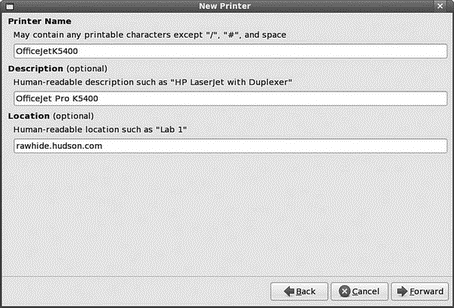Книга: Fedora™ Unleashed, 2008 edition
Creating the Print Queue
Creating the Print Queue
The Fedora system-config-printer tool walks you through a process to create a new print queue, which effectively defines a new printer on your system. To begin configuration of a local (attached) printer, click the New Printer toolbar button in system-config-printer's main window. The New Printer configuration dialog appears, as shown in Figure 8.1.

FIGURE 8.1 Select the appropriate connection method for your printer and enter the relevant details.
Select the connection type that is appropriate for you. You can select a number of different connection types, depending on your specific requirements. Normally you will use the LPT#1 option if your printer is connected by a standard Parallel (or what used to be called Centronics) cable. Alternatively, if you are connecting to a printer that has a JetDirect port (most HP network-capable printers fit in this category), then select the appropriate option and enter the network address for the printer.
Next up you need to select the make/manufacturer of the printer that you are setting up, shown in Figure 8.2.

FIGURE 8.2 Select the make or manufacturer of your printer from this dialog box to help Fedora narrow down the driver options.
Note that you can configure a printer for Fedora even if it is not attached to your computer. After you select your printer's manufacturer, a list of printers from that manufacturer (such as HP, as shown in Figure 8.3) appears. Select your printer from the list, and then click the Forward button.

FIGURE 8.3 Select your printer from the list and click the Forward button to finish the configuration of a locally connected printer.
Do not worry if you do not see your printer listed in the selection; it is possible to select a related, although different, printer model and still be able to print to your printer. For example, many HP printers can be used by selecting the DeskJet 500 for monochrome or 500C model for color printing.
NOTE
You can also browse to http://www.linuxprinting.org/ to find out what drivers to use with your printer or to see a cross-referenced listing of printers supported by each driver. You might also find new and improved drivers for the latest printers on the market.
You can experiment to see which printer selection works best for your printer if its model is not listed. You might not be able to use all the features of your printer, but you will be able to set up printing service. Click Forward when you have made your choice.
The final screen allows you to name your printer and also provide more detailed information to help you identify and manage it (useful if you have a few dozen printers dotted around an office). This screen is shown in Figure 8.4.

FIGURE 8.4 Help yourself by providing information that could be useful if you need to track down the printer for any reason.
The final screen (shown in Figure 8.5) summarizes what system-config-printer is about to do. If you are happy with the details, click the Apply button to commit your changes to the system.

FIGURE 8.5 Double-check the details shown before you commit to creating a new printer entry in /etc/printcap; when you are happy, click Apply to create the new print queue.
When the print queue has been created, you are asked whether you would like to print a test page. Click Yes to save your new printer setup and to print a test page. If you click No, a test page is not printed, and you have to delete the new printer entry or save or cancel your changes before you quit system-config-printer.
You can see the new printer defined in the system-config-printer main window as shown in Figure 8.6.

FIGURE 8.6 New printer entries created in /etc/printcap displayed in system-config-printer's main window.
TIP
You can also configure multiple print queues for the same printer. Use this technique to test printing using different print drivers with the same printer. Create a new queue, give it a specific name (such as testpcl3), and select a different printer. Finish the configuration and print a test page to compare the results against other entries to find the best output. You can also use this technique to define a monochrome or color printer entry for the same printer or to use different drivers for different types of media (such as regular or photo paper).
- Creating and Configuring Local Printers
- Using the Common UNIX Printing System GUI
- 4.4.4 The Dispatcher
- About the author
- Chapter 7. The state machine
- Appendix E. Other resources and links
- Example NAT machine in theory
- The final stage of our NAT machine
- Compiling the user-land applications
- The conntrack entries
- Untracked connections and the raw table
- Basics of the iptables command




